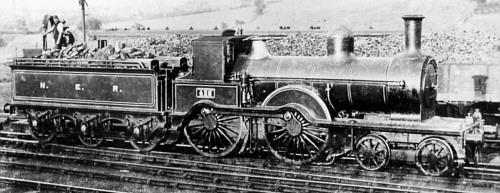The McDonnell NER Class '38' 4-4-0 Locomotives

When Fletcher retired in November 1882, the North Eastern Railway's (NER) largest express passenger type was the '901' Class 2-4-0. His successor, McDonnell came to the NER from the Great Southern & Western Railway (GS&WR) in Ireland. At the GS&WR he had already built up a reputation for re-organise locomotive workshops and standardising designs, as well as introducing a 4-4-0 design for passenger haulage on routes with tight curves. On arriving at the NER, McDonnell quickly started to re-organise the Gateshead Works. He also started to design a new 4-4-0 express locomotive for the NER's increasing passenger loads. Sixteen of the new '38' Class 4-4-0s were built at Gateshead in 1884. Gateshead's production capacity was severely restricted due to the reorganisation, and a further twelve were built by Hawthorn & Co. in 1884-5.
By September 1884, eight '38's had been built, and it was clear that the design suited the NER's secondary duties very well, but it was not the improved express engine that was intended. A number of other things were not going well. McDonnell had replaced a number of design features favoured by Fletcher. These were things like a switch from right-hand drive to left-hand drive, and a removal of the exhaust cocks. The exhaust cocks allowed the driver to exhaust some of the steam directly from the cylinders and not via the blastpipe - hence softening the blast. These changes antagonised the footplate crews who were very loyal to Fletcher. Although many of these features would eventually be adopted and accepted on the NER, the footplate crews of the mid-1880s were simply not going to accept them from McDonnell! The Gateshead Works re-organisation was also going badly with construction dropping to only twelve engines and three replacement boilers per year. All of these factors resulted in McDonnell resigning in September 1884. The NER appears to have accepted some of the blame, and continued to pay McDonnell's salary for another year.
With McDonnell's departure, an order for a third batch of eight '38's was cancelled. These were already under construction, so they were completed as J74 0-6-0T engines. Without a locomotive superintendent, and in desperate need of a good express design, General Manager Henry Tennant chaired a design committee to produce the famous E5 2-4-0 'Tennant' express locomotives.
Although McDonnell was known for standardisation, the '38' locomotives had at least two main variations. The Hawthorn & Co. engines had 4ft 3in diameter boilers with 193 tubes. This compares to the Gateshead engines which had 4ft 1in diameter boilers with 200 tubes. Some contemporary accounts also describe a 190 tube boiler, so this may represent a third variation. The Gateshead engines also had their bogies mounted 4in close to the driving wheels.
There were also a number of detailing differences between the Gateshead and Hawthorn engines. The most prominent of these was the shape of the valence. The Gateshead engines had a more pronounced cut-away section on the valence where it cleared the crank pins. The front end of the frames was also shaped differently. The Gateshead engines had an even taper to the buffer beams, whilst the Hawthorn engines were horizontal with a sharp curve down to the running plate.
The only significant change or rebuilding occurred between 1895 and 1900, when W.Worsdell fitted steel boilers to his own standard design. This boiler had similar dimensions to the McDonnell boilers, but the firebox had a larger water space. This resulted in a reduction in grate area and firebox heating surface.
After their initial poor performance on the main line, the '38' Class engines were quickly relegated to secondary routes. Although there were swaps, the Hawthorn-built engines tended to work between Newcastle and Carlisle, while the Gateshead engines worked in the Southern Division (York, Scarborough, Malton, and Whitby). Their bogie design proved to be particularly useful on these secondary routes. Although their work was generally uneventful, it appears that they performed well on these less demanding routes.
Trials during the summer of 1885 compared a Tennant E5, a '38', and a '901' Class 2-4-0 on the route between Penrith and Darlington. The '38' proved to use 21% more coal than the E5 and 9% more than the '901'. These results pretty much stopped their use on the NER's Central Division.
Restricted to secondary duties, the '38's never clocked up any high mileages. Only one locomotive, No. 281, survived into LNER ownership (1923). This engine was initially allocated to Whitby, but in its later years it was allocated to York. At York it never had any regular duties and was really a spare engine. It was, however, occasionally recorded deputising for X3 2-2-4T No. 1679 hauling the inspection saloon. No. 281's LNER career was very short and it was withdrawn after 47 days.
Technical Details
| Cylinders (x2): | (inside) | 17x24in. |
| Motion: | Stephenson | |
| Valves: | slide | |
| Boiler: | Max. Diameter: | 4ft 3in |
| Pressure: | 140psi | |
| Heating Surface: | Total: | 1097 sq.ft. |
| Firebox: | 98 sq.ft. | |
| Tubes: | 999 sq.ft. (206x 1.75in) | |
| Grate Area: | 15.16 sq.ft. | |
| Wheels: | Leading: | 3ft 1.25in |
| Coupled: | 6ft 8.25in | |
| Tender: | 3ft 8.5in | |
| Tractive Effort: | (@ 85% boiler pressure) | 11,760lb |
| Wheelbase: | Total: | 40ft 6.25in |
| Engine: | 20ft 10.5in | |
| Tender: | 12ft 6in | |
| Weight (full): | Total: | 66 tons 16cwt |
| Engine: | 39 tons 2cwt | |
| Tender: | 27 tons 14cwt | |
| Max. Axle Load: | 14 tons 12cwt |
Preservation
None of the NER Class "38" locomotives survived into preservation.
Models
I am not aware of any models of the NER Class "38" locomotives.
Acknowledgements
Thank you to Malcolm Peirson for the photograph of NER No. 426.